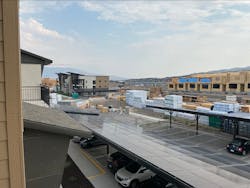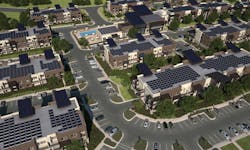How Hard Is It to Build A Virtual Power Plant Anyway?
Nine years ago, I wrote a story for Utility Products magazine called “Solar Forecasting: The Next Big Thing for Solar Power?” I talked to researchers from San Diego who spoke about clouds that “behave” better than others and knowing how powerful the sun will be in a particular location and time means everything when it comes to predicting how bankable and deliverable the solar resource is.
The striking thing about it was they weren’t even using technology that was that advanced. Photovoltaic solar panels themselves have been around since the late 1800s. The project used rounded, silvered “fisheye” mirrors that reflected the skies, reminding me of something from the disco era. Those mirrors were photographed with ordinary cameras, producing live images of the sky over a solar project in real time. What had changed and made solar forecasting possible, researchers said at the time, was how powerful their computers were.
Machines with higher processing power combined with faster remote communications networks — and the lowered cost of both — were the factors that really made this application possible. Taking photos of the sky and combining this with detailed climatological and meteorological data from the area going back years was an elegant solution, combining our knowledge of the past and the data available to us in the present. But could it yield the energy grid of the future?
Now solar power is growing faster than ever. The new administration in the White House is gearing up for a round of renewable energy and distributed energy resource (DER) investment similar to what President Obama was doing when I wrote that story. Back in 2012, utilities had yet to surpass 3 GW of installed solar capacity, according to data from the Solar Energy Industries Association. Last year, utilities reached 53.3 GW of cumulative installed capacity. We are capturing and using more of the sun’s rays, sure, but are we using them as effectively as we could be?
Critics of solar power and renewable energy in general say we can’t power our homes with electricity when we don’t know when and where the sun is shining or the wind is blowing. Also, we lack the capacity to hold this energy, meaning we must use it as quickly as we generate it. Energy storage addresses both problems, but having to rely on generation resources spread out so far from one another is exactly the opposite of the situation our power grids were built for.
A New Concept
At Mandalay Homes’ Jasper planned community in the Prescott Valley, Arizona, town of about 46,500 people, the homes use green building technology and a 23 MWh energy storage system capacity, plus 11.6 MW of total power system output.
According to project partner sonnen Inc., a unit of the German energy company, the Jasper project’s solar-powered homes will be able to communicate with one another, acting as a “hive,” as the company puts it. Another name for this is virtual power plant (VPP).
The Jasper community will work as a unit to flatten the load curve, minimize stress on the grid and keep the carbon footprint down. All this while a self-contained, resilient microgrid is created — capable of powering itself without drawing on the wider area’s electric grid.
Buildings as Pieces of a 'Power Plant'
Geoff Ferrell, senior director of VPP Design, Construction & Operations, with sonnen, said as the Jasper homes are finished and sonnen’s systems brought online, they will provide immediate benefits to homeowners by lowering average monthly bills and powering the homes with renewable energy generated on site. Excess solar power not immediately required can be stored in battery energy storage systems and discharged against household loads during high tariff times when power is more expensive.
“Through these optimizations (known as “solar time shifting”), the homes minimize the potentially damaging impact of variable solar export to the grid and act as a load reducing asset during daily peak periods,” Ferrell said. “Through the rate plans pricing signals, each battery is programmed to respond to these daily cycle periods and perform either a charge or discharge function to achieve maximum savings without requiring lifestyle changes for the homeowner.”
In Utah, the Wasatch Soleil Lofts project operates under different parameters. Here 600 apartment units are networked as an aggregated power reservoir that local utility Rocky Mountain Power can view and directly control.
“The sonnenVPP software platform allows (Rocky Mountain Power) to monitor, schedule and dispatch all the systems in the Soleil Lofts cluster to perform any number of grid related services that provide both local and greater grid support services on demand,” Ferrell said.
Soleil Lofts is currently about 85% built out, according to sonnen. When complete, it will offer 4.8 MW, 12.5 MWh of renewable power that is available to the local circuits.
Rocky Mountain Power, whose most recent resource plan calls for 6,500 MW of wind and solar by 2025 and 600 MW of energy storage, launched its Wattsmart Battery Program as an “evolution” of the Soleil Lofts partnership. Soleil Lofts is an all-electric, 600-unit apartment complex in Herriman, Utah. Each of its units have in-home battery storage managed by Rocky Mountain Power.
“That innovative partnership enabled Rocky Mountain Power to develop a Distributed Battery Grid Management Solution (DBGMS), which allows us to partner with customers through the Wattsmart Battery program to help keep the grid stable as we transition to more renewable energy,” said Bill Comeau, Rocky Mountain Power vice president of customer experience and innovation.
Comeau said networking these distributed assets will help the utility with its energy needs by creating a more dispatchable source of power.
“For the Wattsmart battery program we are focusing on the data and control elements that matter the most, such as real-time storage availability and the ability to dispatch in real-time based upon system conditions,” according to the utility.
For Wattsmart, Rocky Mountain Power paired with sonnen to connect the battery-grid management system to the utility’s energy management system. The Wasatch Group was another partner on this project.
“This will allow us to work with battery manufacturers to connect to our system and aggregate qualified batteries that have the technology to be used as a meaningful utility grid management solution. Currently we are communicating with the batteries through the internet,” according to the utility.
Lower customer bills, utility pricing signals and a self-contained, controllable source of renewable power. This is the promise of the VPP, anyway. But there are many obstacles to be addressed before all this promise can be realized.
High capital investment, needed grid upgrades, a lack of market structures and standards needed to monetize the technology are a few of the problems players in this area identify.
A New Direction Requires New Policies
Brad Williams, vice president of Industry Strategy, Oracle Utilities, said his company sees some barriers to the VPP space on the regulatory side.
“FERC 2222 helps create more value for DER owners and aggregators, but distribution utilities also need incentives from state regulators to participate with aggregators and get them to fully embrace using customer-owned DER as grid-side resources for non-wires alternatives.
Order 2222, finalized Sept. 17, 2020, allows DER aggregators to compete in all regional organized wholesale electric markets. According to FERC, this enables new technologies to come online and participate on a level playing field, enhancing competition, encouraging innovation and driving down costs for consumers.
“Under the new rule, regional grid operators must revise their tariffs to establish DER aggregators as a type of market participant, which would allow them to register their resources under one or more participation models that accommodate the physical and operational characteristics of those resources,” according to a FERC release about Order 2222.
Without state regulator incentives, Williams said, non-wires alternatives essentially defers the utility invested capital rate base and reduces earnings, while shared savings could foster wider adoption.
Robert Tucker, director, Industry Solutions at the Smart Electric Power Alliance agreed with Williams, saying the lack of market structures will limit VPPs by making it more difficult to ensure a return on investment for all involved partners.
“The ISO/RTO’s eventual implementation of FERC Order 2222 will drive more VPP opportunities,” Tucker said. “The impact of that is probably two years away.”
President Joe Biden’s selection of Rich Glick to serve as head of FERC may be an indication that effective ISO/RTO implementation could be in store. Glick has praised Order 2222 before and helped work to finalize it.
Lack of Interoperability
IEEE Life Fellow and former chairman of IEEE’s PES T&D committee Gene Wolf said most utilities seem unaware of the benefits of VPP’s, but third-party aggregators do. They see the VPP as a potential market.
“In real estate it is location, location, location. In digital technology it is standards, standards, standards. The industry needs standards and protocols for the VPP technology. Lack of interoperability held back smart grid technology when it was introduced and it will be the same with VPP,” Wolf said.
Wolf cited the Black & Veatch (B&V) 2020 Megatrends Report’s findings utility upper management’s attitude toward advanced digital technology. The report indicated 25.1% didn’t know what a VPP was and 30.7% didn’t have it on their radar at all. Interestingly, 15.8% were considering VPPs for part of their operations and 8.8% had considered it.
B&V reported that 54.1% of utility leaders polled said budget constraints were their biggest barrier to adopting new technologies. Regulatory hurdles were an issue for another 36.6%. In another section, more than 40% of utility officials polled said regulatory uncertainty is impacting their ability to recover infrastructure investments.
In a question about distribution network challenges, B&V reported 72% of respondents chose “improving reliability” as one of the largest challenges, while 37.2% selected DER integration. (Note: The polls allowed people to select up to three choices.)
More Data, More Problems?
Colin Beaney, vice president, Energy, Utilities & Resources, IFS, said to connect DER assets and address the problem of processing large amounts of data, utilities and grid operators need capable internet of things (IoT) solutions.
“Having access to all of this data is essentially useless without the ability to effectively capture it and present it in real time to make the information actionable,” Beaney said.
Enterprise resource planning (ERP) software with embedded IoT solutions will empower organizations to capture and analyze asset data transmitted by sensors installed on the grid. This kind of system, with the help of application programming interfaces — a kind of software go-between that helps two applications speak to one another — will be able to feed asset data to the central ERP.
“This will enable utilities organizations to aggregate relevant operational data to make informed decisions and trigger activities, such as predictive maintenance, to lower operations costs,” Beaney said.
Wolf added that the “big data” issue is a huge challenge. Utilities must be able to process all the information produced by a potentially massive network of sensors and other control devices. These issues could potentially be addressed with digital twin technology, cloud-based computing, and/or artificial-intelligence-driven data analytics. We have the tools, but this is another area that highlights the need for standards and protocols.
Tom Martin, managing director, Data Science with E-Source, said he views the data side of things as an important issue to be solved, although it is not an insurmountable problem.
“The data challenge isn’t really that big, with cloud computing, it is easy to scale,” Martin said. “We actually maintain that 1000+ attribute data set for all customers nationwide, so it’s no burden on the utilities to put it to work.”
To put the size of the data in perspective, Martin said hourly kilowatt reads coming from a smart meter would reach 1,000 data points per customer in just a little over a month.
“Size isn’t the problem, knowing what to do with the data and how to use it to get insights is what gets tricky,” Martin said.
Current forecasting methods work for understanding a substation’s loading, Martin said, but will typically spread out like peanut butter for everything downstream from the substation.
“When I was at Pacific Gas & Electric we did a technology demonstration project where we partnered with TROVE Predictive Data Science to use data to create a bottom up load forecasting engine that would use a combo of smart meter, sensor data, and third party data to create hyper-localized load forecasting,” Martin said.
By the time smart meter data is collected and ready for use, it is as much as two days old, so operators must compensate for differences in weather, climate, rooftop solar production and other variables that may have changed in the intervening time. Everything must be forecast for today as well as a week out, Martin said.
Getting the Grid to Talk to Itself
Hanna Grene, chief of commercial development at PXiSE Energy Solutions, said the effective integration of DERs at high percentage rates essentially requires an entirely new operating system for the grid. “Not only do we need upgrades to our 100-plus-year-old power grid, but we need a more modern, digital communications network.”
“[T]o integrate disparate DER technologies across the network, they must use an open communications standards, such as the IEEE 2030.5 Standard for Smart Energy Profile Application Protocol. When implemented effectively, the 2030.5 protocol enables the coordination of customer DERs securely using the public communications network including, but not limited to, the Internet, 3G and 4G,” Grene said.
Ultimately, to weave DER resources seamlessly into our grids, utilities must balance supply and demand in real time with many, many more variables. To do this effectively, utilities need to be able to operate the grid autonomously and transition away from the hands-on adjustments required by traditional systems, Grene said.
Grene said the value of DER assets will only be realized when they are integrated into markets, computer sites and the grid in a way that creates shared value and ensures system security and reliability.
“Most use cases for DER support electrification goals and focus on behind-the-meter applications such as onsite power generation, but they do not support the larger grid network or incumbent utility suppliers,” Grene said.
Lessons for A Stronger Grid
Back in the sun-bleached high deserts of Arizona and Utah, Geoff Ferrell said the projects sonnen is building are already yielding important lessons on how this technology can net better results in the future.
“When you are inventing entirely new constructs, education and collaboration are the keys to designing and executing a successful project,” Ferrell said.
Greater adoption of DER technologies like VPPs will come through utility adoption and bi-directional or mutually beneficial policies.
“Certainly, the quarantines associated with the Covid-19 pandemic proved that reliable, resilient energy at home is not only critical to people’s lives, but also their livelihoods,” Ferrell said. “One might even argue that they become even more important in such times.”
For More Information:
sonnen | www.sonnenusa.com
Rocky Mountain Power | www.rockymountainpower.net
Oracle Utilities | www.oracle.com
Smart Electric Power Alliance | www.sepapower.org
Institute of Electrical and Electronics Engineers | www.ieee.org
Black & Veatch | www.bv.com
IFS | www.ifs.com
E-Source | www.esource.com
PXiSE | www.pxise.com
About the Author
Jeff Postelwait
Managing Editor
Jeff Postelwait is a writer and editor with a background in newspapers and online editing who has been writing about the electric utility industry since 2008. Jeff is senior editor for T&D World magazine and sits on the advisory board of the T&D World Conference and Exhibition. Utility Products, Power Engineering, Powergrid International and Electric Light & Power are some of the other publications in which Jeff's work has been featured. Jeff received his degree in journalism news editing from Oklahoma State University and currently operates out of Oregon.





